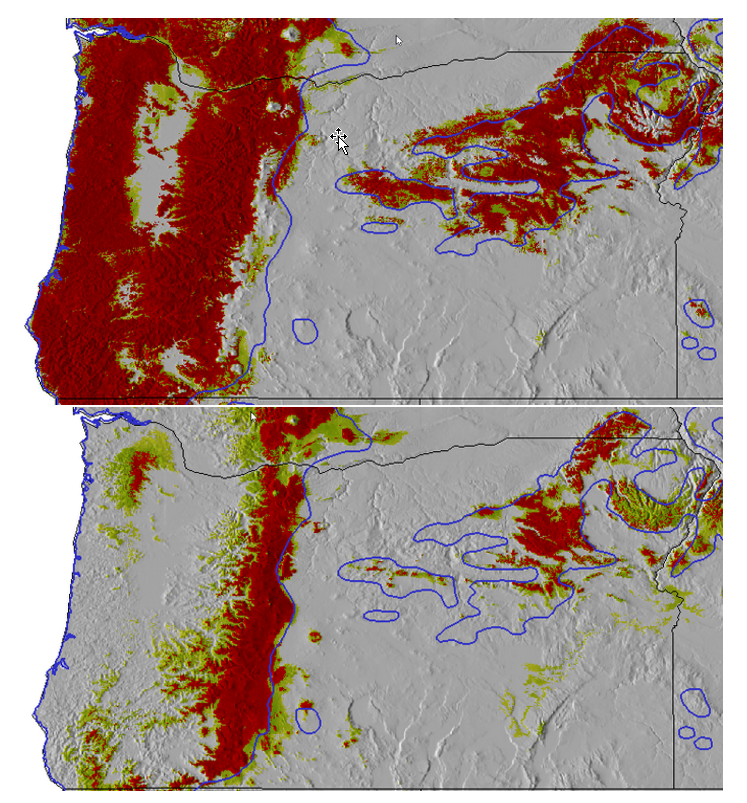Why Climate Smart Management?
by Alan Journet, Co-facilitator, Southern Oregon Climate Action Now
Like all species, trees are physiologically adapted to a range of environmental conditions. Where environmental conditions are optimal, the species can grow successfully; where they are sub-optimal viability is depressed, or the trees are absent.
Since continued global warming and its climate change consequences have become evident (Figure 1) and inevitable (Figure 2), planning for future forests is being modified to include uncertainty about future conditions as an essential component of thinking. Climate smart principles result in a rethinking of the management goal of restoration of forest conditions to the historic range of variability since future conditions may be very different and outside that historic range.
Figure 1
Figure 2 - Lower
Figure 2 - Upper
Current (above) and late-century (below) viability of Douglas fir in Oregon as imposed by the projected changing climate. Purple is high viability shading to green and yellow with lower viability, and grey absent. http://charcoal.cnre.vt.edu/climate/species/
Figure 3
Unfortunately, when we look at our forests today, we see examples of stands looking like those depicted in Figure 3, a stand of expiring Douglas firs in the Applegate Valley likely compromised by climate change. This offers a harbinger of our future if we do not modify our goals and tactics to reflect the changing conditions. An example of the potential impact of future climate on the viability of a local tree species is indicated in Figure 4.
Vegetation communities in the six regions on the globe that enjoy a Mediterranean (winter wet: summer dry) climate are universally fire prone, fire adapted and fire dependent. Since we live in a Mediterranean (winter wet: summer dry) climate, local species are adapted to fire, and some are even dependent on it for long-term species maintenance. As a result, fire, a well demonstrated tool for classical restoration, is also a tool in the “climate smart” kit. Also, since many of our regional forests are unusually dense as a result of a history of fire suppression, thinning the understory also becomes one of the tools to be carried over from classical restoration management to climate smart management.
Figure 5
The difference however, is that the adaptive cycle embodied in “climate smart” management (Figure 5) requires conscious recognition that future climatic conditions will be much different from past conditions. This results in the manager not making a commitment to achieving a certain forest composition derived from historic conditions, but that he/she establishes goals consistent with a range of plausible or forecasted future climatic conditions. It must be acknowledged, however, that plausible or forecastable future conditions provide us only with a range of probabilities for potential future conditions not certainties. This might well result in realistically revising project goals. The principles then demand continual re-evaluation of the consequences of management actions including assessment of the trajectories in forest structure and function that result, measuring them against the goals, and again potentially revising the goals as a result. It must be acknowledged than maintaining forest function may require employing either different species than those historical present or representative of the same species but from of different geographic origin and thus different genotype. Throughout project conduct, adaptation options are identified, evaluated and implemented.
Practitioners are encouraged to avoid committing to one specific predetermined goal or the application project-wide of one particular strategy, but to adopt an adaptive management approach (such as looking for a range of opportunities at a broad geographic scale) that allows for revisions in tactics and goals as assessment dictates.
Major differences between the climate smart approach and the classical approach are the “climate smart” encouragement for climate change vulnerability assessments, scenario planning, and experimenting with various management strategies while emphasizing the need for extensive monitoring of the impact of these strategies on critical forest values and adjusting both goals and strategies should such seem necessary.
Thanks to members of the Southern Oregon Climate Smart (SOCS) Working Group for their contributions to this brief summary. Any errors, however, remain my responsibility - AJ







